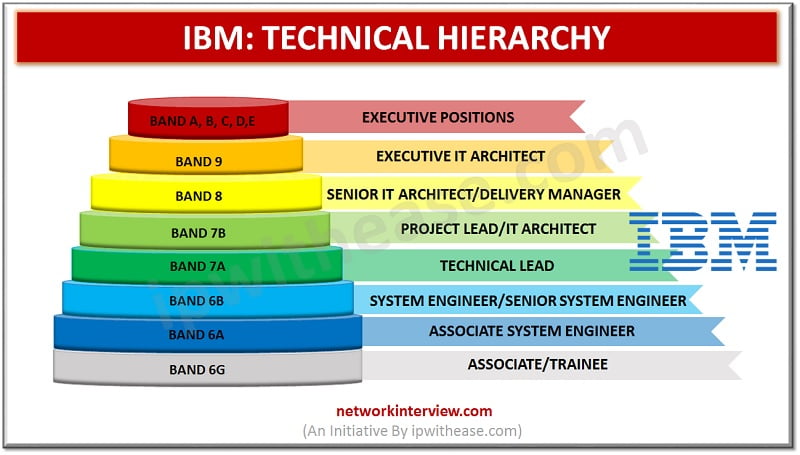
IBM: Technical Hierarchy
It is a common interest to know about the position you are going to be hired and its hierarchy in the chain of command. But it is not easy to know the internal workings of organizations. Do you want to know about the Hierarchy infrastructure of IBM?
In this article, you will know the different positions and their place in the IBM chain of command. Before getting into the content, here is something you need to know about IBM.
A Short Introduction to IBM
For those who don’t know about IBM, here is a short introduction to it.
IBM or International Business Machine Corporation is the oldest and largest company in the world.
It is an American multinational technology corporation headquartered in Armonk, New York, with operations in over 171 countries. The employee strength is 4,00,000 (2022)
It was founded in 1911 in Endicott, New York, by Charles Ranlett Flintas, as the Computing-Tabulating-Recording Company (CTR) and was renamed “International Business Machines” in 1924.
As on today, it is the best global technology company that offers hardware, software, and cloud-based applications for both business and scientific research.
Technical Hierarchy of IBM
From the above introduction, you should be clear that IBM is a Multinational Company with complex internal management. And it is very hard to clearly explain the hierarchy as IBM is a merger of 4 major companies. But there is some inside information available for us.
The designation Hierarchy can vary based on the department like HR, Finance, Research, Marketing, etc… To keep it simple, this article only discusses the technical Hierarchy of the IT or Technical personnel in IBM.
You can also watch this video for better understanding:
IBM Band System:
In corporate IBM the band system is used. Here the numbers of bands are allocated to each person based on the amount of responsibility they undertake.
The entry-level is band 6G and is followed by band 6A, 6B, 7A, 7B,band 8 and then band 9. Above Band 9, comes executive bands A, B, C, D, E.
Band 6G: Entry Level Band
A Fresher/Graduate joins at this level and is designated as associates/trainees.
The annual salary of a trainee varies from 3-7 lakhs INR.
After one year of training they are promoted to the next band.
Band 6A
The technical designation assigned is Associate System Engineer/ASE
The annual salary of an ASE varies from 4-8 lakhs INR.
After 2-4 years of experience they are promoted to the next band.
Band 6B
The designations that comes under this band are: System Manager, Senior System Manager, etc.
The annual salary varies from 6-12 lakhs INR.
After 4-6 years of experience they are promoted to the next band.
Band 7A
Mostly, you join this level as a Tech Lead.
The annual salary of a tech lead can vary from 10-20 lakhs INR.
Minimum 5 years of experience is required for the persons joining from other companies and for an IBM insider minimum 7 years experience is required to reach at this level.
After getting good experience, you will be promoted to next level. The promotion after this level is an uphill task.
Band 7B
The designations that comes under this band are: Project Lead, IT Architect, etc.
Minimum 10-12 years of overall experience is required to reach at this band level.
After getting good experience, you will be promoted to next level.
Band 8
The designations that comes under this band are: Senior IT Architect, Delivery Manager, etc.
The annual salary at this band level is above 25 lakhs INR.
After getting vast experience at this level, you will be promoted to next band.
Band 9
The designations like Executive IT Architect comes under this band.
The annual salary at this band level is between 25-40 lakh.
Minimum 15-20 years of overall experience is required to reach at this band level. This band is regarded as the highest in technical chain of command, as after this band the roles shifts more towards executive responsibilities.
Executive bands A, B, C, D, E
These bands cover executive positions like: CEO, Regional heads, etc.
For Example, the Band E is given to a Country Head.
Key Notes:
- Bands may vary slightly based on country or department, but the overall structure remains consistent globally.
- Compensation at each band includes both salary and bonus potential, with higher bands offering more significant stock options, bonuses, and leadership responsibilities.
- Promotion from one band to the next typically involves performance evaluations, project leadership, technical skill growth, and contribution to business outcomes.
If you have any further doubts regarding the hierarchy of IBM please leave them in the comment section below.
***The salary packages are only indicative and may vary as per the rise and low of the demand.***
Continue Reading:
Technical Hierarchy of Tech Mahindra
Business Process Manager – Roles & Responsibilities
Are you preparing for your next interview?
Please check our e-store for e-books on Interview Q&A on IT technologies. All the e-books are in easy to understand PDF Format, explained with relevant Diagrams (where required) for better ease of understanding.




